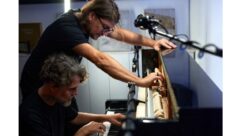

The multi-pattern large diaphragm condenser (LDC) is often a focus in aspirational studio glamour shots—mostly because it’s a key, useful tool, and partly because it’s generally one of the priciest items in a pro’s kit. Recognizing both the needs and desires of, for example, aspiring volunteer recordists in houses-of-worship recording facilities to budget-dictated pros in municipal theaters and beyond, Sennheiser’s MK Series has recently expanded to two models, offering the taste, vibe, and features of high-end LDCs at very reasonable prices. With Sennheiser’s brand already well respected in the live sound realm, and deservedly so, their leap into the affordable LDC fray is both savvy and effective.
Having previously used the excellent MK 4—a Sennheiser cardioid LDC made at the company’s HQ in Germany for $299 street—I jumped at the opportunity to try the MK 8 ($699 street), its multi-pattern sibling, also made in the same German factory. It’s a super useful workhorse for many potential users and applications. And like the MK 4, the MK 8 isn’t a budget mic; it’s just a bargain.
Key features of the MK 8 include a 24-carat gold-plated 1in. dual-diaphragm transducer; omni, wide cardioid, cardioid, super cardioid, and figure-eight polar patterns; -10dB and -20dB pads; -6dB/octave at 100Hz and -18dB/octave at 60Hz high-pass filters; and a 140dB SPL maximum SPL. It comes with the uniquely great yet spartan MZQ 4 microphone clamp, pouch, and instruction manual. From its front, the MK 8 is nearly identical to the MK 4; its backside reveals HPF, pattern and attenuation, respectively. The MK Series is pretty; for reference, its silver metal body and black accenting looks nearly identical to the Mac Book Pro. It feels sturdy, strong, and refined in the hand, too.
Response-wise, the MK 8 is remarkably flat across the 20Hz to 20kHz frequency range with only slight added high-end emphasis between 5kHz to 10kHz, as much as 5dBV, varying from pattern to pattern Omni and wide cardioid emphasis is nearer to 10kHz while supercardioid and figure-eight rises and falls between 3kHz to 10kHz.

On the back of the MK8, polar pattern selection as well as multiple setting low frequency roll-off and pad parameters are available.
Overall, the MK 8 offers an open, efficient, and clean performance. In order of usefulness, I applied it in lead vocal, multiple vocal, acoustic guitar, drum room, room overhead, acoustic ensemble, electric bass guitar cabinet, among other jobs. Tracks were eminently usable, and vocal, acoustic instrument, and room/overhead sound sources were remarkably good; for $1,400 street, a pair of these would work well most everywhere multi-pattern LDCs are used, and I doubt many would ever know they weren’t using a far more expensive German microphone.
On that note, I also had the opportunity to employ the cardioid-only MK 4 alongside the MK 8 set to cardioid. The MK 4 and MK 8 employ the same 1in. diaphragm, and Sennheiser’s provided specs for both LDCs show that, while they aren’t identical in frequency response—the MK 8’s cardioid is slightly flatter—these MK Series models are damn near identical and certainly close enough for rock ‘n’ roll stereo overheads on drums, multi-genre ensemble stereo room microphones, and much more. As such, the MK 4’s performance was virtually indistinguishable from its multi-patterned sibling in a mix, though isolated A/B comparisons would show some frequency-based variances if positioned side-by-side, aimed to capture the same source. For that reason, I’d even recommend picking up an MK 8 and an MK 4 if cardioid LDC coverage is sufficient for most of your stereo miking needs, thus saving $400 while having one super-useful multi-pattern MK LDC on hand for other “crucial source” applications.
I love the niche Sennheiser has carved out for the MK Series. The brand already inspires confidence, and now they offer a largely uncolored LDC Series made alongside Neumann models at an amazingly good price. Knowing that, I’d say that these MK Series models practically sell themselves.
Strother Bullins is NewBay Media’s reviews editor, AV/Pro Audio Group, active musician, recordist, and club-level sound reinforcement wrangler. [email protected]
PRODUCT SUMMARY
COMPANY: Sennheiser | sennheiser.com
PRODUCTS: Sennheiser MK Series MK 4 and MK 8 Large Diaphragm Condenser (LDC) Microphones
PROS: Incredible value; largely uncolored frequency response; flexibility in application; German build quality
CONS: None noted
APPLICATIONS: Studio, home studio, house-of-worship/theater recording and live sound capture
PRICES (LIST): $799 and $299 (MK 8 and MK 4, respectively)
SPECIFICATIONS
DIAMETER OF DIAPHRAGM: 1in.
ACOUSTIC OPERATING PRINCIPLE: pressure gradient transducer
PICKUP PATTERNS: omni, wide cardioid, cardioid, super-cardioid, figure-of-eight (MK 8); cardioid (MK 4)
FREQUENCY RESPONSE: 20Hz–20kHz
MAXIMUM SPL: 140dB SPL (@ 0dB attenuation, MK 8)
DYNAMIC RANGE: 130dB
LOW CUT/ROLL-OFF FILTER, SWITCHABLE (MK 8): roll-off, -6 dB/oct., cut-off frequency, 100Hz; low-cut, -18dB/oct., cut-off frequency, 60Hz
ATTENUATION, SWITCHABLE (MK 8): 0dB, -10dB, -20dB
DIAMETER: 2.24in.
LENGTH: 6.29in.
WEIGHT: 1.06lbs.










